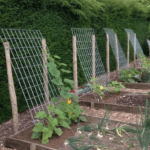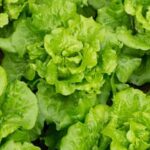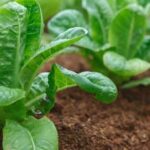Nova Scotia, located on the eastern coast of Canada, is known for its stunning landscapes and vibrant gardening scene. One of the highlights of gardening in this region is the abundance of vegetables that can be grown.
From crisp and juicy tomatoes to tender leafy greens, Nova Scotia offers a wide range of produce for home gardeners to enjoy. Whether you are a seasoned gardener looking to expand your knowledge or a beginner ready to embark on your first vegetable garden adventure, this article will provide valuable insights into Nova Scotia’s gardening vegetables.
In this comprehensive guide, we will delve into various aspects of vegetable gardening specifically tailored to the unique growing conditions of Nova Scotia. We will explore the climate insights that make this region distinct and understand how it affects successful cultivation. Additionally, you will find a month-by-month planting guide that will help you make informed decisions about when to sow different vegetable varieties.
We will also unveil the top vegetable varieties for Nova Scotia gardeners, ensuring that you choose seeds that thrive in this particular climate. Furthermore, we provide invaluable tips on soil preparation and fertilization techniques to enhance nutrient-rich soil, enabling optimal vegetable growth. Pest control techniques specific to common garden pests in Nova Scotia will be shared as well as secrets to harvesting and storing vegetables to preserve their flavor and nutrition.
Throughout this article, we aim to highlight various community gardening initiatives in Nova Scotia where individuals come together to share knowledge, experiences, and resources. Moreover, expert advice from experienced local gardeners will give insight into their triumphs and successes when it comes to cultivating vegetables in this region. So grab your gardening gloves and get ready to embark on an exciting journey through Nova Scotia’s bountiful world of gardening vegetables.
Climate Insights
Nova Scotia’s unique climate presents both challenges and opportunities for vegetable gardening. Understanding the specific growing conditions in this region is essential for successful cultivation.
Temperature Variations
Nova Scotia experiences a moderate climate with distinct seasonal changes. Summers are relatively short, and temperatures can range from mild to hot, depending on the location within the province. The coastal areas tend to be cooler due to the influence of the ocean, while inland regions experience slightly higher temperatures. Winters are typically cold and snowy, with temperatures dropping below freezing. Gardeners should plan their planting schedules accordingly and choose vegetables that can thrive in these temperature variations.
Moisture Levels
The province of Nova Scotia receives a significant amount of precipitation throughout the year, making it an ideal environment for vegetable gardening. However, it is important to note that rainfall can vary depending on location. Coastal areas generally experience more rainfall compared to inland regions. It is crucial for gardeners to monitor moisture levels in their soil regularly and adjust irrigation practices accordingly. Mulching can also help retain moisture and prevent water loss through evaporation.
Frost Dates
One of the key considerations for vegetable gardening in Nova Scotia is the frost dates. The last spring frost usually occurs in late May or early June, while the first fall frost typically arrives in September or October.
These frost dates define the growing season and determine when it is safe to plant sensitive crops outdoors. It is advisable to consult a local frost date chart or contact agricultural extension services to get accurate information about specific plantings dates based on your location within Nova Scotia.
Understanding these unique growing conditions will assist novice and experienced gardeners alike in selecting appropriate vegetables for their gardens and maximizing their harvests throughout the year. With proper planning and attention to these factors, gardeners can enjoy a rich bounty of delicious and nutritious vegetables from their Nova Scotia gardens.
Seasonal Planting Guide
Introduction
Nova Scotia offers a unique and bountiful opportunity for vegetable gardening. With its temperate climate and fertile soil, gardeners in this province can experience a diverse range of vegetables throughout the year. To make the most of your gardening efforts, it is essential to have a seasonal planting guide that outlines which vegetables to plant each month. This article will provide you with a month-by-month breakdown for vegetable gardening in Nova Scotia.
Spring Planting (March to May)
Spring is an exciting time for gardeners in Nova Scotia as the ground begins to thaw and new life emerges. In March, you can start preparing your soil by loosening it and adding compost or organic matter to enhance its fertility. By April, you can begin planting cool-season crops such as peas, lettuce, radishes, and spinach. It is important to protect these early plantings from late frosts by covering them with row covers or cloches.
As May approaches, the weather gets warmer, allowing for the planting of warm-season vegetables like tomatoes, peppers, cucumbers, and beans. Make sure to give them proper support structures if needed and keep an eye out for pests that become more active during this time.
Summer Planting (June to August)
Summer is the peak growing season for vegetable gardens in Nova Scotia. In June, continue sowing warm-season crops like corn, zucchini, summer squash, and melons. As temperatures rise in July and August, focus on providing adequate moisture through regular watering schedules.
To extend your harvest into the fall months, consider succession planting by sowing quick-maturing varieties every few weeks. Remember to mulch your beds regularly to retain moisture and prevent weed growth.
Fall Planting (September to November)
Fall brings cooler temperatures but still allows for successful vegetable gardening in Nova Scotia. In September, start planting frost-tolerant vegetables such as kale, broccoli, carrots, and beets. These crops will thrive in the cooler weather and some even develop sweeter flavors after exposure to light frost.
As October and November arrive, protect your plants from early frosts by covering them with blankets or using cold frames. Consider incorporating cover crops like clover or winter rye to enrich your soil during winter months.
By following this month-by-month breakdown for vegetable gardening in Nova Scotia, you can enjoy a continuous harvest throughout the seasons. Stay tuned for more information on the top vegetable varieties suitable for this region in the next section of this article.
Top Vegetable Varieties
Nova Scotia is home to a wide variety of vegetables that thrive in its unique climate and growing conditions. In this section, we will unveil the best seed choices for Nova Scotia gardeners, taking into consideration their adaptability to the local environment and their delicious flavors.
One of the top vegetable varieties that Nova Scotia gardeners should consider planting is the Yukon Gold potato. This yellow-fleshed potato is known for its excellent flavor and versatility in cooking. It grows well in the cool, moist climate of Nova Scotia and can be planted as early as April. Another great choice for potatoes is the Kennebec variety, which produces high yields and has excellent disease resistance.
For those looking to grow tomatoes, the Stupice tomato is highly recommended for Nova Scotia gardens. This heirloom variety is an early producer and has good tolerance to cooler temperatures. The cherry-sized fruits are packed with flavor, making them perfect for fresh eating or canning. Another popular tomato variety for Nova Scotia is the Manitoba variety, known for its ability to withstand cooler weather conditions.
When it comes to leafy greens, the Buttercrunch lettuce is a favorite among Nova Scotia gardeners. This variety forms tight heads with tender leaves that have a sweet and buttery flavor. It can be harvested from late spring through summer when grown in succession plantings. For kale lovers, the Lacinato kale, also known as dinosaur kale or Tuscan kale, is an excellent choice. Its dark blue-green leaves have a rich flavor and remain tender even when fully matured.
| Vegetable | Variety |
|---|---|
| Carrot | Scarlet Nantes |
| Cucumber | Marketmore |
| Green Bean | Roma II |
| Pepper | King of the North |
| Zucchini | Black Beauty |
By selecting these top vegetable varieties, Nova Scotia gardeners can maximize their chances of a successful harvest and enjoy the flavors of locally grown produce. Experimenting with different varieties can also add excitement and diversity to your vegetable garden. With the right seed choices, gardening in Nova Scotia can be a rewarding experience.
Soil and Fertilization Tips
One of the key factors for successful vegetable gardening in Nova Scotia is having nutrient-rich soil. The quality of the soil directly affects the growth and development of plants, as well as the taste and nutritional value of the vegetables produced. In this section, we will explore some soil and fertilization tips that can help enhance the fertility of your garden soil for optimal vegetable growth in Nova Scotia.
Firstly, it is important to test your soil to determine its pH level and nutrient content. Soil testing kits are available at local gardening centers or through agricultural extension offices. These tests will provide valuable information about the existing conditions in your soil and guide you in making necessary amendments. Generally, most vegetables prefer a slightly acidic to neutral pH range between 6.0 and 7.0.
Once you have determined the pH level of your soil, you can take steps to adjust it if necessary. If your soil is too acidic, adding lime can help raise the pH level. Conversely, if your soil is too alkaline, sulfur or aluminum sulfate can be used to lower the pH. It is important to follow package instructions when applying these amendments to ensure correct dosage.
In addition to adjusting the pH level, enriching your soil with organic matter is essential for providing essential nutrients and improving its overall structure. Organic matter can be added through composting, using aged manure or leaf mulch, or by incorporating cover crops into your gardening rotation. These organic materials break down over time, releasing nutrients into the soil and improving its ability to retain water.
Soil Testing Results
| Nutrient | Optimal Range | Your Soil Test Result |
|---|---|---|
| Nitrogen (N) | 35-50 ppm | 40 ppm |
| Phosphorus (P) | 20-30 ppm | 25 ppm |
| Potassium (K) | 150-250 ppm | 200 ppm |
Once your soil has been enriched with organic matter, you may also consider using fertilizers to supplement specific nutrient requirements. Fertilizers can provide an extra boost of nutrients that may be lacking in your soil. It is important to choose a fertilizer that is specifically formulated for vegetable gardening and follow the instructions for application rates carefully.
Pest Control Techniques
One of the biggest challenges that gardeners in Nova Scotia face is dealing with common garden pests. These pests can cause significant damage to vegetable plants and undermine the hard work and effort put into cultivating a successful garden. However, by implementing effective pest control techniques, gardeners can win the battle against these pesky invaders and protect their precious crops.
There are several methods that can be employed to control garden pests in Nova Scotia. One approach is to use natural or organic pest control methods. This involves using environmentally-friendly techniques and products to deter or eliminate pests without harming beneficial insects or pollinators. Examples of natural pest control methods include companion planting, where certain plants are grown together to repel or attract specific pests, as well as the use of organic insecticides derived from plant-based ingredients.
Another effective pest control technique is crop rotation. This involves periodically changing the location of vegetable crops within the garden to disrupt pest life cycles and reduce the buildup of specific pests in the soil. By rotating crops each season, gardeners can help prevent the spread of diseases and limit the impact of destructive insects.
In addition, physical barriers such as fences, netting, or row covers can be used to keep out larger pests like rabbits or birds. These barriers create a physical barrier between the plants and potential threats, preventing them from reaching and damaging crops. Regular monitoring of plants for signs of pest infestation is also crucial so that action can be taken at the earliest signs of trouble.
By implementing these pest control techniques, Nova Scotia gardeners can effectively protect their vegetables from common garden pests. With proper planning and diligence in maintaining a healthy garden environment, they can ensure a bountiful harvest year after year.
Harvesting and Storage Tips
Nova Scotia’s gardening vegetables offer a bountiful harvest, bursting with flavor and nutrition. However, in order to fully enjoy the rewards of your hard work, it is essential to know the secrets to preserving the freshness and taste of your garden bounty. This section will provide you with essential harvesting and storage tips that will help extend the life of your fruits and vegetables while maintaining their nutritional value.
When it comes to harvesting vegetables, timing is crucial. Each vegetable has its own optimal time for harvest, so it is important to be observant and keep track of the maturity dates for each variety. Generally, vegetables should be harvested when they are at their peak ripeness for the best flavor and texture. Be sure to use sharp pruning shears or a knife to prevent damage to both the plant and the produce.
Once your vegetables are harvested, proper storage techniques are vital to maintain their freshness. For leafy greens such as lettuce or kale, it is best to wash them thoroughly before storing them in a plastic bag with a damp paper towel. This will keep them hydrated while preventing wilting. Root vegetables like carrots or potatoes should be stored in a cool, dark place with good ventilation to prevent rotting.
To preserve the nutritional content of your garden bounty, consider freezing or canning your produce. Freezing is a simple method that helps retain most nutrients in fruits and vegetables. Blanching them briefly before freezing can help maintain color and texture. Canning involves heating prepared foods in jars under high temperatures to kill bacteria that could cause spoilage. This method allows for long-term storage without compromising taste or quality.
By following these harvesting and storage tips, you can ensure that your Nova Scotia gardening vegetables remain fresh, flavorful, and nutrient-rich long after they have been picked from your garden. Whether you choose to eat them immediately or preserve them for later use, these secrets will help you make the most of your garden bounty throughout the year.
Community Gardening Initiatives
Nova Scotia is known for its thriving community gardening initiatives, which have become an integral part of the province’s agricultural landscape. These initiatives bring together individuals and communities who share a passion for gardening and a desire to connect with nature. By participating in these initiatives, gardeners not only enjoy the benefits of growing their own vegetables but also contribute to the overall well-being of their communities.
One popular form of community gardening in Nova Scotia is the establishment of community gardens. These are plots of land that are collectively maintained by a group of individuals or families. Community gardens provide opportunities for people without access to suitable land or resources to grow their own produce. They also foster a sense of camaraderie and create spaces where people can come together to learn from one another and share their gardening knowledge.
In addition to traditional community gardens, there has been a rise in other innovative community gardening models in Nova Scotia, such as rooftop gardens and vertical farming. Rooftop gardens utilize otherwise unused urban spaces to grow vegetables, helping to increase the availability of fresh produce in densely populated areas.
Vertical farming, on the other hand, involves growing crops in vertically stacked layers using hydroponics or aeroponics systems. These innovative approaches maximize limited space while minimizing water usage and maximizing crop productivity.
Furthermore, Nova Scotia’s community gardening initiatives extend beyond just individual projects. There are various organizations and networks dedicated to supporting and promoting community gardens throughout the province. These organizations provide resources, funding, and technical expertise to help gardeners succeed in their endeavors. They also facilitate networking opportunities and events where gardeners can come together to exchange ideas, showcase their harvests, and celebrate their accomplishments.
Expert Advice and Success Stories
Nova Scotia is home to a vibrant community of passionate gardeners who have perfected the art of vegetable gardening in this unique region. In this section, we will delve into the insights and experiences of local gardeners who have achieved great success in growing vegetables in Nova Scotia. Through their expert advice and inspiring success stories, you will gain valuable knowledge and tips to elevate your own vegetable gardening endeavors.
Interview with Jane Thompson: Overcoming Challenges and Growing Healthy Crops
Jane Thompson, a seasoned gardener from Halifax, Nova Scotia, has been cultivating her vegetable garden for over 20 years. When asked about the key challenges she faces as a gardener in this region, Jane emphasized the importance of understanding the local climate and adapting accordingly. She explained that Nova Scotia’s short growing season can be a limiting factor for some crops, but with careful planning and selecting fast-maturing varieties, she has managed to achieve bountiful harvests.
One of her top tips for success is to start seeds indoors early in the season. By starting seeds indoors in late winter or early spring, she is able to get a head start on the growing season and extend it further into the fall. This allows her to grow tender crops like tomatoes and peppers that require a longer growing period.
Inspiring Success Story: Jim Murray’s Thriving Organic Garden
Jim Murray, a dedicated organic gardener from Cape Breton Island, shared his remarkable success story of transforming his backyard into a thriving organic vegetable garden. Jim believes that creating healthy soil is the foundation for successful gardening. He shared his techniques for improving soil fertility by incorporating compost made from kitchen scraps and yard waste into his garden beds.
One of Jim’s secrets to success lies in companion planting – a technique where certain plants are grown together to maximize pest control or enhance growth. For example, he plants marigolds around his tomatoes to repel pests and uses basil as a companion plant for his beans, which helps improve their flavor.
Through these interviews, it is evident that Nova Scotia’s gardeners have developed unique strategies to overcome the challenges posed by the region’s climate and soil conditions. Their expertise, innovative techniques, and inspiring stories serve as an invaluable resource for vegetable gardeners in Nova Scotia and beyond. By adopting their advice and practices, you too can achieve abundant harvests and experience the joy of vegetable gardening in this beautiful province.
Conclusion
In conclusion, gardening vegetables in Nova Scotia offers a wealth of rewards and benefits. Through understanding the unique growing conditions and following a seasonal planting guide, gardeners can experience an abundance of fresh and flavorful produce throughout the year.
By choosing the right vegetable varieties and implementing proper soil and fertilization techniques, gardeners can optimize their plant growth and yield. Additionally, by utilizing effective pest control techniques and following harvesting and storage tips, the flavor and nutrition of the garden bounty can be preserved.
Moreover, Nova Scotia’s gardening community is thriving with active initiatives that promote community gardening and knowledge sharing. Engaging with local gardeners through expert advice sessions or success stories allows individuals to learn from experienced professionals and gain inspiration from their triumphs. These interactions create valuable connections within the gardening community while also fostering a sense of camaraderie among fellow enthusiasts.
Overall, embracing the rewards of Nova Scotia gardening vegetables goes beyond just enjoying the delicious produce. It provides an opportunity to connect with nature, nurture plants from seed to harvest, and contribute to a sustainable food system.
Furthermore, it offers a chance for individuals to take part in a supportive community of like-minded individuals who are passionate about growing their own food. So, whether you are already an experienced gardener or just starting out on this exciting journey, Nova Scotia’s rich soil, favorable climate conditions, and vibrant gardening community make it an ideal location for reaping the many benefits of vegetable gardening.
Frequently Asked Questions
What crops grow well in Nova Scotia?
Nova Scotia’s climate and soil conditions are well-suited for growing a variety of crops. Some of the crops that thrive in this region include apples, blueberries, potatoes, cabbage, carrots, onions, and various grains such as wheat and oats.
The province’s cool summers and mild winters create an environment conducive to these crops’ growth and development. Additionally, the coastal location provides a maritime climate that helps certain fruits and vegetables flourish.
What veggies grow well in NZ?
New Zealand’s temperate climate allows for a diverse range of vegetables to be grown successfully throughout the country. Popular veggies that thrive in New Zealand include tomatoes, lettuce, spinach, broccoli, peas, beans, peppers (capsicums), carrots, cucumbers, zucchinis (courgettes), and potatoes.
The fertile soil combined with favorable weather conditions supports healthy plant growth and high yields. Furthermore, New Zealand has a long growing season which allows for multiple planting cycles throughout the year.
When can I plant my tomatoes outside in Nova Scotia?
The ideal time to plant tomatoes outside in Nova Scotia is typically after the threat of frost has passed. In this region, the last frost date usually occurs in late May or early June. It is crucial to wait until the soil has warmed up sufficiently before transplanting tomato seedlings outdoors.
This ensures that they won’t suffer from cold shock or frost damage. However, it is also important to check local weather patterns each year as they can vary slightly from season to season. Starting tomato seeds indoors several weeks prior to the last frost date can help extend the growing season and give seedlings a head start before being planted outside.

If you’re looking to get into vegetable gardening, or are just looking for some tips on how to make your current garden better, then you’ve come to the right place! My name is Ethel and I have been gardening for years. In this blog, I’m going to share with you some of my best tips on how to create a successful vegetable garden.





